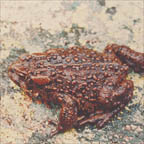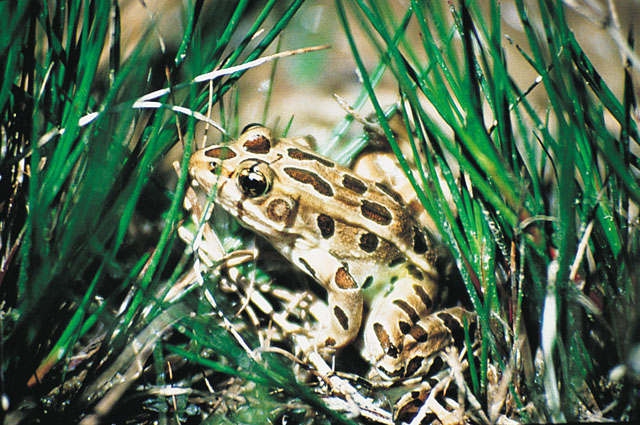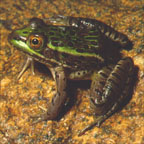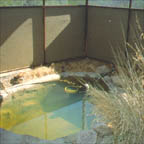Each image is a link to enable you to download high resolution versions of the images. Please note that these might take some time to download.
 |
|
Boreal toad. Photographer: Stephen Corn, USGS.
Boreal toad (Bufo boreas boreas) from Rocky Mountain National Park, Colorado (federal candidate species; listed as endangered by the state of Colorado; the species has undergone about an 80% decline in southern Rocky Mountains). |
| |
 |
|
Aerial photo of farm ponds and contoured farmland.
Photographer: Rick Gillis
Farm ponds have been built since the 1930's to reduce soil erosion and provide water for livestock. |
| |
 |
|
Northern Leopard frog.
Photographer: C. Drost, USGS. |
| |
 |
|
Photo by M.R. Jennings, UGSG. |
| |
 |
|
Sick tiger salamander from the Cottonwood Lake Study Area, Stutsman county, North Dakota, showing discoloration of the skin that first appears. |
| |
 |
|
Sick tiger salamander from the Cottonwood Lake Study Area, Stutsman county, North Dakota, showing discoloration of the skin that first appears. |
| |
 |
|
Sick tiger salamander from the Cottonwood Lake Study Area, Stutsman county, North Dakota, showing discoloration of the skin that first appears. |
| |
 |
|
Biological science technicians sampling salamander populations at the Cottonwood Lake Study Area, Stutsman County, North Dakota. |
| |
 |
|
Biological science technicians sampling salamander populations at the Cottonwood Lake Study Area, Stutsman County, North Dakota. |
The following images link to high resolution tif images which you may download.
 | | The Chiricahua leopard frog is absent from about 80 percent of its historical localities in the United States. Photo by Cecil Schwalbe, USGS; photo taken at Buenos Aires National Wildlife Refuge, Ariz., July 1994
|
| |
 | |
A bullfrog eating a bat at San Bernardino National Wildlife Refuge, Ariz. In Arizona, native leopard frogs no longer occur at sites where bullfrogs are common. Photo by Cecil Schwalbe, USGS, May 26, 1996. |
| |
 | |
Interior of the ranarium--a place where frogs are raised or kept--at San Bernardino National Wildlife Refuge, Ariz. Photo by Phil Rosen, University of Arizona, March 20, 1998 |
| |
 | |
Rancher Matt Magoffin and refuge manager Kevin Cobble seining to rescue Chiricahua leopard frogs and tadpoles from a drying pond on the Magoffin Ranch, Ariz. Photo by Phil Rosen, University of Arizona, March 8, 1994.
|
| |
 | |
Rancher Matt Magoffin and volunteer Julia Rosen viewing Chiricahua leopard frogs at pond on Magoffin Ranch, Ariz. Photo by Phil Rosen, University of Arizona, Oct. 9, 1994. |
| |
 | |
Artificial habitat created for native fishes, leopard frogs and garter snakes at San Bernardino National Wildlife Refuge, Ariz. Photo by Cecil Schwalbe, USGS, Aug. 13, 1998 |
| |
 |
|
Photograph of the Pacific treefrog. Photo by Gary Fellers, USGS. |
| |
 |
|
A photograph of a high sierran lake with mountain yellow-legged frogs. Photo by Gary Fellers, USGS. |
The following images are links to enable you to download either Quicktime or RealMedia video files of
different amphibians. If you would like a copy of the footage for use. For more
information contact Karen Wood at (703) 648-6849. Please note that these might take some time to download.




 A Quicktime file showing different amphibians.
A Quicktime file showing different amphibians.  A RealMedia File showing different amphibians.
A RealMedia File showing different amphibians.